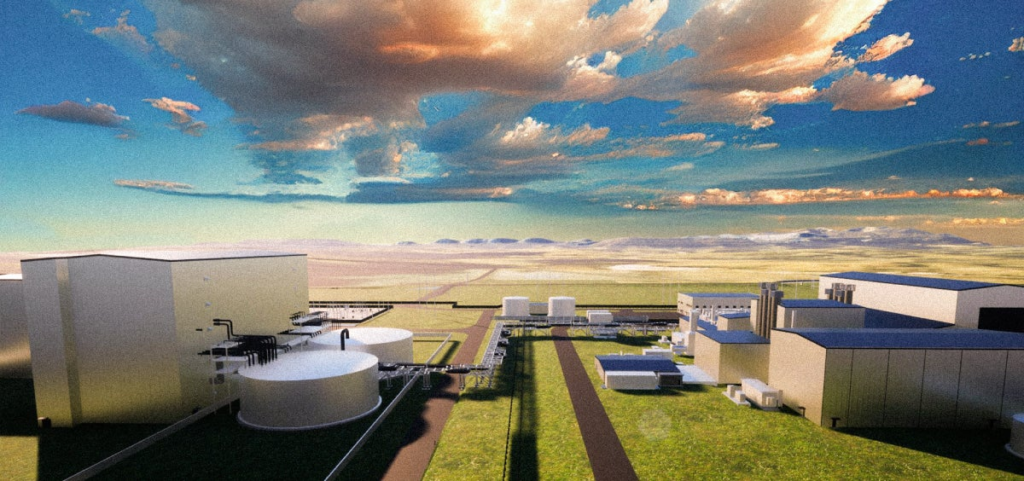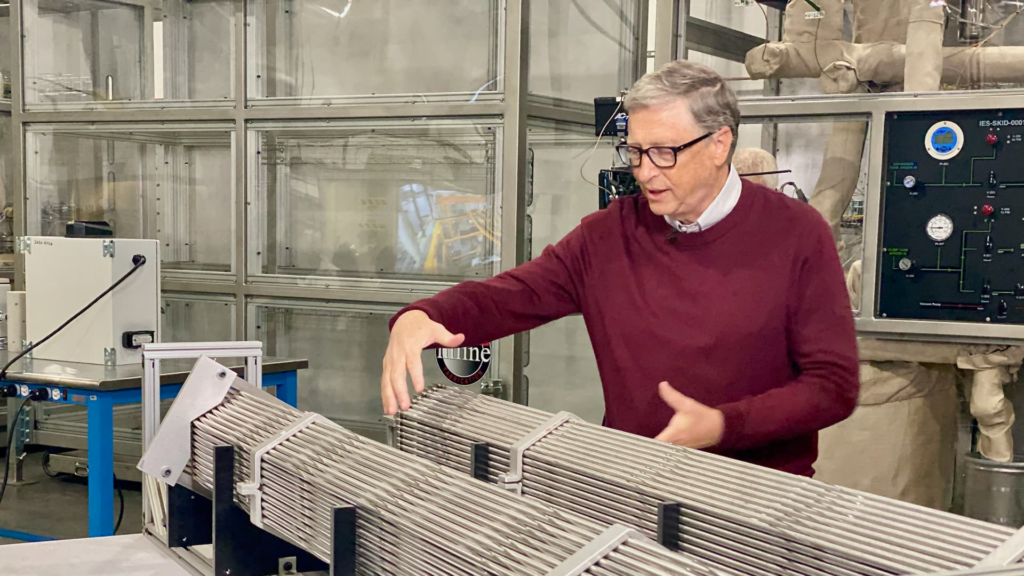“We are at the exact location of the future reactor!” exclaims American billionaire Bill Gates, standing in front of a construction site. It is on this site in Kemmerer, Wyoming (United States), that the first mini-nuclear power plant is expected to be operational by 2030. Founded by Bill Gates, the startup TerraPower aims to use sodium to cool these next-generation plants.

TerraPower promises more cost-effective plants, three times smaller than current models. “We will need much less concrete, less steel. There will be much fewer electrical cables and pipes. Thanks to this, our plants will be simpler to build and will require less manpower,” explains TerraPower CEO Chris Levesque in the featured report. Moreover, the heat produced by the reactor can be stored and reused, resulting in less energy wastage.
In addition to the United States, where the entire nuclear sector is buzzing with innovative projects, many companies aim to use the current model of nuclear power plants but on a much smaller scale.
Last Energy, an innovative American startup, is pushing the boundaries of nuclear energy with its ambitious goal to fit a reactor into a compact cube barely larger than a house. In a paradigm shift from traditional nuclear power plants, Last Energy envisions the entire power plant occupying no more than a football field. The strategic intent is to mass-produce these modular units, designed to be easily transported, and deploy them in remote regions that are distant from conventional electrical grids.
Founder Bret Kugelmass elucidates that Last Energy’s model is engineered for efficient manufacturing in a factory setting, utilizing modular components that can be seamlessly transported to diverse locations. This innovative approach not only streamlines the construction process but also opens up possibilities for bringing electricity to areas that are traditionally challenging to connect to centralized power networks.
The emphasis on simplicity in construction is a key aspect of Last Energy’s vision, potentially revolutionizing the accessibility and deployment of nuclear energy technology. By reducing the scale and complexity of traditional nuclear power plants, Last Energy contributes to the ongoing evolution of nuclear energy towards greater efficiency, cost-effectiveness, and environmental sustainability. This streamlined and modular approach could pave the way for a more widespread and eco-friendly utilization of nuclear energy, aligning with global efforts to transition towards cleaner and more sustainable energy sources.

Nearly 70 mini-reactor projects are being studied worldwide, including in France. The emergence of these innovative nuclear projects, focusing on smaller and more modular designs, is seen by some as a potential future for nuclear energy. This shift not only aims to reduce construction costs and simplify logistics but also holds promises for energy sustainability and environmental conservation. These advancements present an alternative to the traditional giant reactors, offering the potential for more accessible and widespread use of nuclear energy while minimizing environmental impact. As nations discuss the expansion of nuclear capacities globally, these mini-reactors could play a significant role in shaping the future of nuclear energy and contributing positively to our planet’s ecological well-being.

TerraPower is an American nuclear technology company founded in 2006 by Bill Gates and a group of investors. The company is developing a molten salt reactor (MSR), a type of nuclear reactor that uses liquid salt as a coolant and moderator. MSRs are considered to be a promising technology for the future of nuclear power because they offer a number of advantages over traditional reactors, including:
- Safety: MSRs are inherently safe because the molten salt coolant and moderator cannot melt down, even if the reactor loses power.
- Efficiency: MSRs can operate at higher temperatures than traditional reactors, which makes them more efficient.
- Sustainability: MSRs can use spent nuclear fuel as fuel, which reduces the need for new uranium mining.
TerraPower has been working on developing its MSR technology for over a decade. In 2020, the company announced that it had partnered with the U.S. Department of Energy to build a demonstration reactor in Kemmerer, Wyoming. The reactor is expected to be operational by 2028.
In addition to its work on MSRs, TerraPower is also developing other technologies that could help to improve the safety and efficiency of nuclear power. These technologies include:
- Molten salt energy storage: Molten salt can be used to store energy from renewable sources, such as solar and wind power. This could help to make the grid more reliable and resilient.
- Advanced fuel cycles: TerraPower is developing new fuel cycles that could make nuclear power more sustainable. These fuel cycles would use spent nuclear fuel as fuel, which would reduce the need for new uranium mining.
TerraPower stands as a pioneering force within the nuclear power industry, spearheading innovations that have the capacity to redefine the landscape of nuclear energy. With an unwavering commitment to safety, efficiency, and sustainability, TerraPower is at the forefront of developing groundbreaking solutions. The company’s visionary approach is poised to usher in a new era in nuclear power, addressing challenges and concerns associated with traditional models. By harnessing advanced technologies and methodologies, TerraPower aims to not only enhance the safety standards of nuclear power plants but also significantly improve their efficiency, making them a more viable and attractive option for meeting the world’s growing energy demands. This commitment to innovation positions TerraPower as a key player in shaping the future of nuclear energy on a global scale.
Related Content
- McDonald’s introducing a host of environmentally conscious features aimed at enhancing energy efficiency and visitor convenience
- HD Hyundai Oilbank’s Strategic Transformation into an Eco-friendly Energy Platform: A Comprehensive Analysis
- IBM used AMD’s other not-so-secret weapon to deliver yet another brain-like chip — NorthPole is faster and uses less energy than Nvidia’s best AI GPU and it’s only the beginning
- UK bill payers may have to cover £6bn cost of failed energy firms, warn MPs
- Households in Great Britain at risk of losing winter energy help, charity warns
- Innovating Solar Energy: Raja Yazigi’s Breakthrough Night-and-Day Solar Panel
- How TerraPower is leading the nuclear renaissance
- TerraPower, a Nuclear Innovation Company
- Dow’s Corpus Christi project highlights challenge of nuclear energy’s revival
- Exclusive: Bill Gates on the future of nuclear energy, AI
- U.S. Bets on Small Nuclear Reactors to Help Fix a Huge Climate Problem
